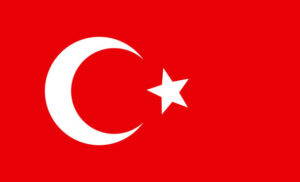History of the Turkish Flag
Origin of the Flag
The story of the Turkish flag begins with a rich history that spans centuries. The current flag’s origins date back to the late 18th and early 19th centuries when it was adopted as the flag of the Ottoman Empire in 1844. The design of the flag was not a mere coincidence but a result of significant historical and political developments.
The Flag in the Turkish Republic
After the establishment of the Turkish Republic in 1923, the same design continued to be used as the national flag. This continuity reflects the desire to preserve traditions and national symbols even amid the significant political and social transformations the country experienced.
Colors of the Flag and Their Meanings
The Red Color
The red color in the flag symbolizes courage and sacrifice for the homeland. This color dates back to the Ottoman era when it was used in the flags of the long-lasting Ottoman Empire. The red color reflects the blood shed in wars and the struggle for independence.
The Crescent and Star
The crescent is an ancient Islamic symbol, representing the Islamic religion and Turkey’s deep-rooted Islamic culture. The five-pointed star symbolizes light and hope, further enhancing the symbolism of unity and cooperation among the Turkish people. Together, the crescent and star form a scene that represents the bond between the people and the spiritual values they cherish.
Uses of the Turkish Flag
In National Celebrations
It is hoisted during national celebrations such as Republic Day and Victory Day. These occasions are opportunities for the Turkish people to express their pride in their country and the sacrifices of their ancestors for freedom and independence. The flag flies everywhere, from government buildings to homes and streets.
In Daily Life
It is not just a national symbol used only on special occasions; it is part of the daily life of Turks. It adorns government buildings, schools, and even homes and streets. The flag represents the pride of the Turkish people and reflects the sacrifices of their ancestors for freedom and independence.
Myths and Symbols Surrounding the Flag
Historical Myths
Many myths surround the flag, enhancing its symbolic value. One famous myth tells that the crescent and star appeared in the sky on the night of a great battle, giving hope to the Turkish soldiers and inspiring them to victory. This myth reflects the deep connection between the Turkish people and the flag’s spiritual and national values.
National Symbols
The crescent and star are not just symbols on the flag; they represent values and ethics that enhance unity and cohesion among the Turkish people. The crescent reflects Islam, and the star symbolizes light and hope. Together, they form a strong symbol of national solidarity and belonging.
It is not just a piece of colored fabric but an expression of national identity, history, culture, and values that unite the Turkish people. The flag reflects a long history of courage and sacrifice and expresses unity and hope for a bright future. It is a symbol of national pride and solidarity among the people, remaining an integral part of the daily life of Turks, raised on national occasions and adorning public and private places, enhancing the spirit of fraternity and belonging.
Frequently Asked Questions About the Turkish Flag
What is the difference between the flags of Tunisia and Turkey?
The main difference between the flags of Tunisia and Turkey lies in the details of the symbols used. The flag has a red background with a white crescent and five-pointed star in the center, while the Tunisian flag has a red background with a white circle in the center containing a red crescent and star.
What do the star and crescent on the Turkish flag mean?
The crescent and star on the flag symbolize Islam and Islamic traditions. The crescent was a symbol of the Ottoman Empire, and the five-pointed star is a symbol of light and hope.
What does the Turkish flag signify?
It is signifies national unity and the long history of courage and sacrifices made by the Turkish people. The red color symbolizes the blood of martyrs, and the crescent and star symbolize Islamic heritage and national identity.
Which is older, the flag of Tunisia or Turkey?
The current form of the Turkish flag was adopted in 1844, while the current form of the Tunisian flag was adopted in 1831. Therefore, the Tunisian flag is slightly older than the Turkish flag.
Why is the Turkish flag red?
The red color in the Turkish flag symbolizes courage and sacrifice for the homeland, a color that dates back to the Ottoman era when it was used in the flags of the Ottoman Empire.
How old is the Turkish flag?
The Turkish flag in its current form was adopted in 1844, making it more than 180 years old.
Who designed the Turkish flag?
The Turkish flag cannot be attributed to a single person, as it evolved from the flags of the Ottoman Empire and was officially adopted during the reign of Sultan Abdulmejid I in 1844.
What does the blue Turkish flag represent?
The flag resembling the Turkish flag but in blue is the flag of Northern Cyprus, known as the Turkish Cypriot flag. This flag shares the crescent and star symbols with the Turkish flag but differs in its primary color, which is blue, with two horizontal white stripes at the top and bottom.
The Turkish Cypriot Flag
It is used in Northern Cyprus, an area that declares itself the Turkish Republic of Northern Cyprus, though it is recognized only by Turkey. This flag represents the Turkish identity of the Turkish Cypriots and is heavily inspired by the Turkish flag, differing in color and design.
Who are the Ottomans today?
The Ottomans were the ruling family of the Ottoman Empire, and after the empire’s fall in the early 20th century, there is no longer a reigning Ottoman family. Today, the Ottomans are part of Turkish history and heritage.
Why is Turkey called by that name?
The name “Turkey” comes from the Latin word “Turcia,” meaning “Land of the Turks.” The Turks are the main ethnic group in the country, shaping its history and culture.
What is the symbol of Turkey?
The national symbol of Turkey is the national flag with its red background and white crescent and star. Additionally, the winged eagle is a historical symbol.
How many colors does the Turkish flag have?
The Turkish flag has only two colors: red (background) and white (crescent and star).
What is the oldest flag in the world?
The oldest flag in the world is the flag of Denmark, known as the “Dannebrog,” which has been in use since the 13th century.
What is the oldest flag in the Arab world?
The oldest flag in the Arab world is the flag of the Sultanate of Oman, dating back to the 7th century.
Who discovered Turkey?
Turkey was not discovered in the traditional sense, as it has always been inhabited. However, the Greeks and Romans were among the most notable civilizations to colonize and influence the region historically.
What does the blue eye in Turkey mean?
The blue eye, known as “Nazar Boncugu,” is an amulet used in Turkish culture to protect against envy and the evil eye. It is believed to bring luck and ward off negative energies.
What is the flag of Turkey?
The flag of Turkey is the national red flag with a white crescent and star. It is the official symbol of the Republic of Turkey and is used in all national and official events.
Who was before the Ottoman Empire?
Before the Ottoman Empire, there were many political entities and empires in Anatolia, including the Seljuk Empire.
Which country occupied Turkey?
Turkey itself was not occupied as a unified state, but it was part of the Ottoman Empire, which ruled vast territories before its disintegration after World War I.
Who founded Turkey?
Modern Turkey was founded by Mustafa Kemal Atatürk in 1923 after the fall of the Ottoman Empire and the end of the Turkish War of Independence.
When did the Turkish flag appear?
The current form of the Turkish flag appeared and was officially adopted in 1844 during the Ottoman Empire.
Which flag has a crescent and star?
The flag with a crescent and star is the Turkish flag. This design is a symbol of Islam and represents Turkish national identity.
What is the shape of Turkey?
Turkey is almost rectangular and is located at the intersection of Europe and Asia. It is bordered by the Black Sea to the north and the Mediterranean Sea to the south, with neighbors like Greece, Bulgaria, Syria, and Iraq.
Source: Turkey invest
To read the latest articles please visit the home page of Turk Blogs.





